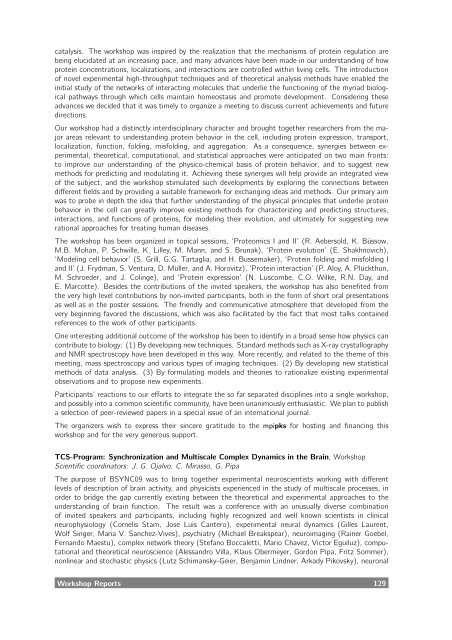Contents - Max-Planck-Institut für Physik komplexer Systeme
Contents - Max-Planck-Institut für Physik komplexer Systeme
Contents - Max-Planck-Institut für Physik komplexer Systeme
Create successful ePaper yourself
Turn your PDF publications into a flip-book with our unique Google optimized e-Paper software.
catalysis. Theworkshopwasinspiredbytherealizationthatthemechanismsofproteinregulationare<br />
beingelucidatedatanincreasingpace,andmanyadvanceshavebeenmadeinourunderstandingofhow<br />
proteinconcentrations,localizations,andinteractionsarecontrolledwithinlivingcells.Theintroduction<br />
ofnovelexperimentalhigh-throughputtechniquesandoftheoreticalanalysismethodshaveenabledthe<br />
initialstudyofthenetworksofinteractingmoleculesthatunderliethefunctioningofthemyriadbiologicalpathwaysthroughwhichcellsmaintainhomeostasisandpromotedevelopment.<br />
Consideringthese<br />
advanceswedecidedthatitwastimelytoorganizeameetingtodiscusscurrentachievementsandfuture<br />
directions.<br />
Ourworkshophadadistinctlyinterdisciplinarycharacterandbroughttogetherresearchersfromthemajorareasrelevanttounderstandingproteinbehaviorinthecell,includingproteinexpression,transport,<br />
localization,function,folding,misfolding,andaggregation. Asaconsequence,synergiesbetweenexperimental,theoretical,computational,andstatisticalapproacheswereanticipatedontwomainfronts:<br />
toimproveourunderstandingofthephysico-chemicalbasisofproteinbehavior,andtosuggestnew<br />
methodsforpredictingandmodulatingit.Achievingthesesynergieswillhelpprovideanintegratedview<br />
ofthesubject,andtheworkshopstimulatedsuchdevelopmentsbyexploringtheconnectionsbetween<br />
differentfieldsandbyprovidingasuitableframeworkforexchangingideasandmethods.Ourprimaryaim<br />
wastoprobeindepththeideathatfurtherunderstandingofthephysicalprinciplesthatunderlieprotein<br />
behaviorinthecellcangreatlyimproveexistingmethodsforcharacterizingandpredictingstructures,<br />
interactions,andfunctionsofproteins,formodelingtheirevolution,andultimatelyforsuggestingnew<br />
rationalapproachesfortreatinghumandiseases.<br />
Theworkshophasbeenorganizedintopicalsessions,‘ProteomicsIandII’(R.Aebersold,K.Büssow,<br />
M.B.Mohan,P.Schwille,K.Lilley,M.Mann,andS.Brunak),‘Proteinevolution’(E.Shakhnovich),<br />
‘Modelingcellbehavior’(S.Grill,G.G.Tartaglia,andH.Bussemaker),‘ProteinfoldingandmisfoldingI<br />
andII’(J.Frydman,S.Ventura,D.Müller,andA.Horovitz),‘Proteininteraction’(P.Aloy,A.Plückthun,<br />
M.Schroeder, andJ.Colinge), and‘Proteinexpression’(N.Luscombe, C.O.Wilke, R.N.Day, and<br />
E.Marcotte). Besidesthecontributionsoftheinvitedspeakers,theworkshophasalsobenefitedfrom<br />
theveryhighlevelcontributionsbynon-invitedparticipants,bothintheformofshortoralpresentations<br />
aswellasinthepostersessions. Thefriendlyandcommunicativeatmospherethatdevelopedfromthe<br />
verybeginningfavoredthediscussions,whichwasalsofacilitatedbythefactthatmosttalkscontained<br />
referencestotheworkofotherparticipants.<br />
Oneinterestingadditionaloutcomeoftheworkshophasbeentoidentifyinabroadsensehowphysicscan<br />
contributetobiology:(1)Bydevelopingnewtechniques.StandardmethodssuchasX-raycrystallography<br />
andNMRspectroscopyhavebeendevelopedinthisway.Morerecently,andrelatedtothethemeofthis<br />
meeting,massspectroscopyandvarioustypesofimagingtechniques.(2)Bydevelopingnewstatistical<br />
methodsofdataanalysis. (3)Byformulatingmodelsandtheoriestorationalizeexistingexperimental<br />
observationsandtoproposenewexperiments.<br />
Participants’reactionstooureffortstointegratethesofarseparateddisciplinesintoasingleworkshop,<br />
andpossiblyintoacommonscientificcommunity,havebeenunanimouslyenthusiastic.Weplantopublish<br />
aselectionofpeer-reviewedpapersinaspecialissueofaninternationaljournal.<br />
Theorganizerswishtoexpresstheirsinceregratitudetothe mpipksforhostingandfinancingthis<br />
workshopandfortheverygeneroussupport.<br />
TCS-Program:SynchronizationandMultiscaleComplexDynamicsintheBrain,Workshop<br />
Scientificcoordinators:J.G.Ojalvo,C.Mirasso,G.Pipa<br />
ThepurposeofBSYNC09wastobringtogetherexperimentalneuroscientistsworkingwithdifferent<br />
levelsofdescriptionofbrainactivity,andphysicistsexperiencedinthestudyofmultiscaleprocesses,in<br />
ordertobridgethegapcurrentlyexistingbetweenthetheoreticalandexperimentalapproachestothe<br />
understandingofbrainfunction. Theresultwasaconferencewithanunusuallydiversecombination<br />
ofinvitedspeakersandparticipants, includinghighlyrecognizedandwellknownscientistsinclinical<br />
neurophysiology (Cornelis Stam, Jose Luis Cantero), experimental neural dynamics (Gilles Laurent,<br />
WolfSinger,MariaV.Sanchez-Vives),psychiatry(MichaelBreakspear),neuroimaging(RainerGoebel,<br />
FernandoMaestu),complexnetworktheory(StefanoBoccaletti,MarioChavez,VictorEguiluz),computationalandtheoreticalneuroscience(AlessandroVilla,KlausObermeyer,GordonPipa,FritzSommer),<br />
nonlinearandstochasticphysics(LutzSchimansky-Geier,BenjaminLindner,ArkadyPikovsky),neuronal<br />
WorkshopReports 129
















